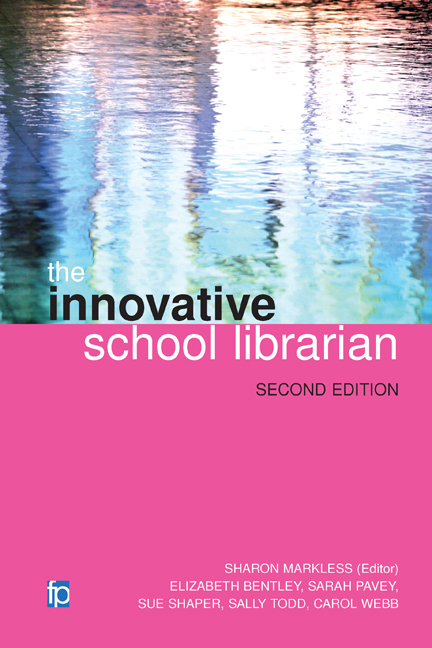Book contents
- Frontmatter
- Contents
- Preface
- Acknowledgements
- PART 1 WHO IS THE LIBRARIAN?
- PART 2 YOUR COMMUNITY: FROM PERCEPTIONS TO PRACTICE
- PART 3 MOVING FORWARD
- 7 Inspiration
- 8 Becoming integral to teaching and learning
- 9 Innovation
- Appendix 1 Levels of education
- Appendix 2 School library self-evaluation questions
- Appendix 3 An example of a completed self-evaluation summary sheet
- Appendix 4 SWOT analysis
- Appendix 5 Choosing priorities in development planning: sample grid
- Appendix 6 Example of a force field analysis: a tool for managing change
- Appendix 7 Managing change: process and principles
- References
- Index
8 - Becoming integral to teaching and learning
from PART 3 - MOVING FORWARD
Published online by Cambridge University Press: 08 June 2018
- Frontmatter
- Contents
- Preface
- Acknowledgements
- PART 1 WHO IS THE LIBRARIAN?
- PART 2 YOUR COMMUNITY: FROM PERCEPTIONS TO PRACTICE
- PART 3 MOVING FORWARD
- 7 Inspiration
- 8 Becoming integral to teaching and learning
- 9 Innovation
- Appendix 1 Levels of education
- Appendix 2 School library self-evaluation questions
- Appendix 3 An example of a completed self-evaluation summary sheet
- Appendix 4 SWOT analysis
- Appendix 5 Choosing priorities in development planning: sample grid
- Appendix 6 Example of a force field analysis: a tool for managing change
- Appendix 7 Managing change: process and principles
- References
- Index
Summary
We believe that becoming an integral part of the teaching and learning process is an important goal for school librarians. However, in the literature of school librarianship, and indeed the whole field of librarianship, integration is presented as the Utopia, which implies that we may aspire to but never achieve it. We believe, on the contrary, that becoming integral to teaching and learning within schools is not only a valid aspiration for school librarians but achievable. It is the process of working together with members of our school community to achieve integration that gives real purpose to our work.
Integration is also the process whereby the librarian and the library become essential parts of the school at all levels. As we have said already, this is part of serving the community in which we work, a core part of any librarian's role. Becoming integrated involves:
• looking at structure and staffing
• considering where the librarian sits within the internal management of the school
• making constructive relationships within the school community
• thinking about the place the library and the librarian occupy within teaching and learning
• working to be a visible part of the solution to the students’ learning needs. (Streatfield and Markless, 1994)
We recognize that integration may take place at different points along a continuum from working with an individual teacher to whole school involvement. Levels of integration fluctuate over time, as the school's management structure, curriculum and personnel change.
Although our aim of supporting the core purposes of the organization should be constant, we need to determine what form integration might take according to context.
We each need to build a vision of what integration looks like in our workplace. There will be a range of possibilities, which need to be linked to the librarian's capabilities, opportunities and aspirations to create a dynamic response to the teaching and learning culture of the school.
How, then, do we achieve integration with the rest of the school? It can be done in any of the following ways:
• through becoming an integral part of the teaching team
• through forging constructive relationships
• by sustaining integration into teaching and learning
• by being innovative with physical and virtual library space
• by using the virtual library
• by playing a role in the management of the school.
- Type
- Chapter
- Information
- The Innovative School Librarian , pp. 129 - 142Publisher: FacetPrint publication year: 2016



